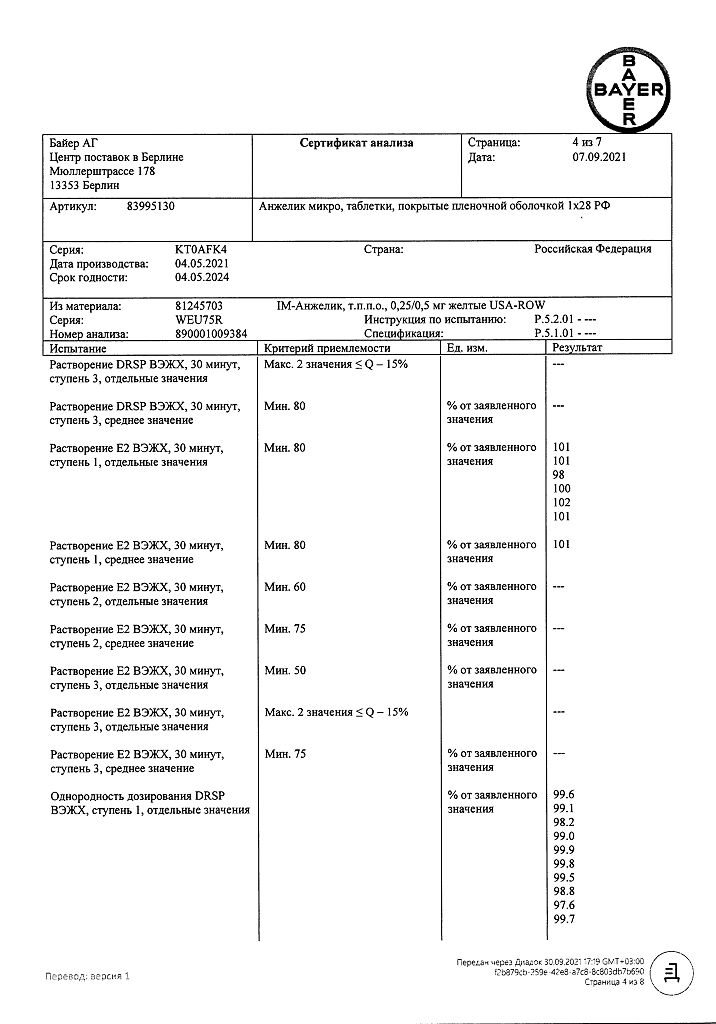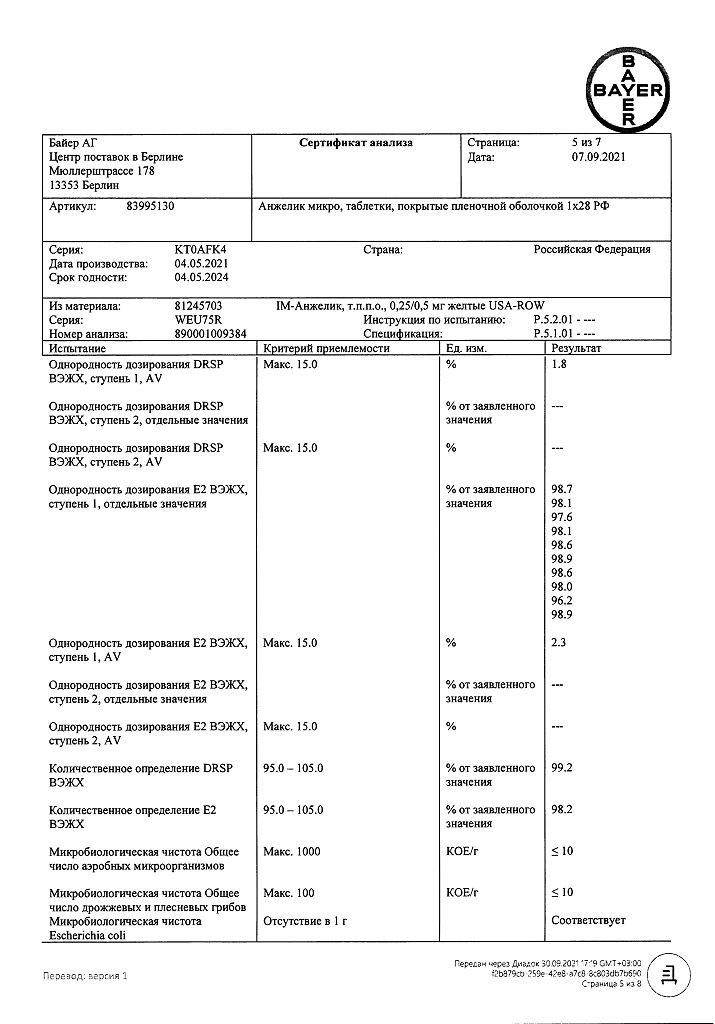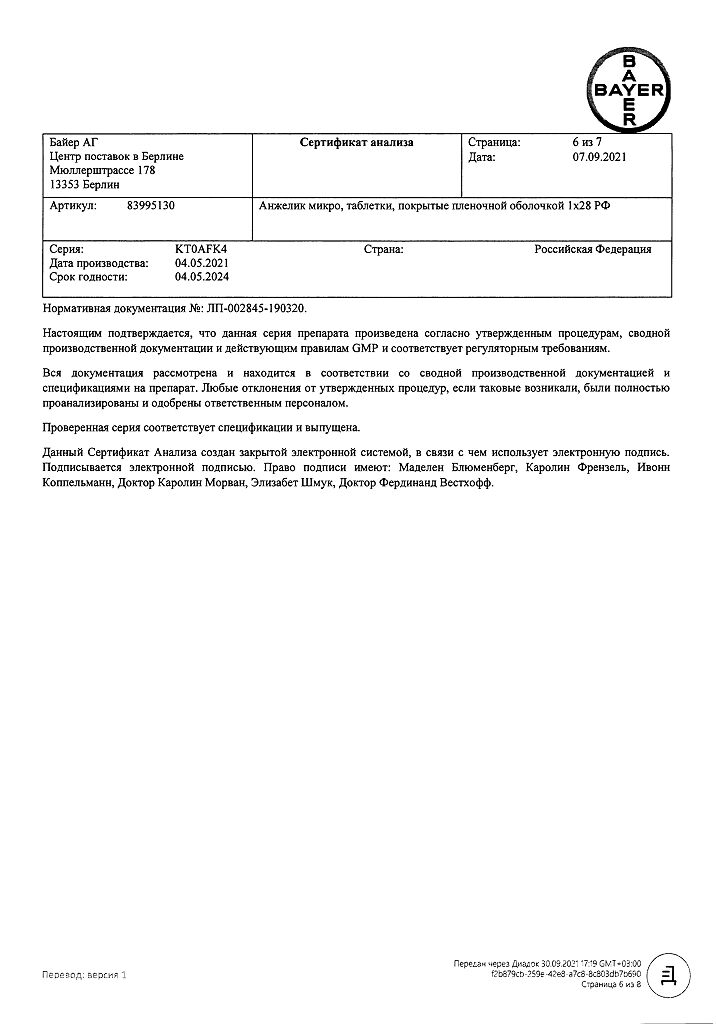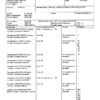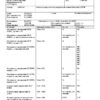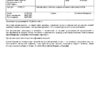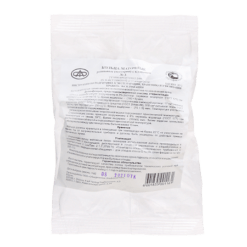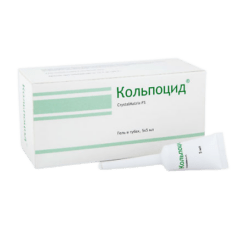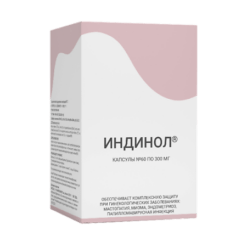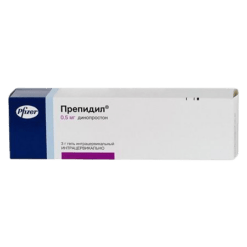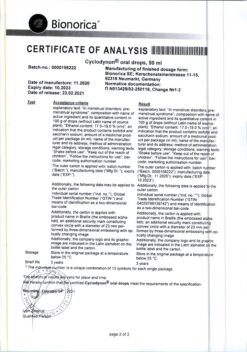No products in the cart.
Angelic Micro, 28 pcs.
€51.22 €42.69
Description
Angelik Micro contains 17-estradiol, chemically and biologically identical to endogenous human estradiol, and the synthetic progestagen drospirenone. 17-estradiol provides hormone replacement during and after menopause. The addition of drospirenone provides bleeding control and counteracts the development of estrogen-induced endometrial hyperplasia.
Effects of estradiol
The decline in ovarian function, accompanied by decreased estrogen and progesterone production, leads to menopausal syndrome, which is characterized by vasomotor and organic symptoms. Hormone replacement therapy (HRT) is indicated for the treatment of these symptoms.
Of all natural estrogens, estradiol is the most active and has the greatest affinity (binding force) to estrogen receptors. Target organs for estrogen include, but are not limited to, the uterus, hypothalamus, pituitary gland, vagina, mammary glands, and bone (osteoclasts).
Other effects of estrogen include: lower blood insulin and glucose concentrations, receptor-mediated vasoactive effects and receptor independent effects on smooth muscle cells of vascular walls. Estrogen receptors have been identified in the heart and coronary arteries.
Oral administration of natural estrogens has advantages in cases of hypercholesterolemia due to more favorable effects on lipid metabolism in the liver.
Monotherapy with estrogens has a dose-dependent stimulatory effect on endometrial mitosis and proliferation and thus increases the incidence of endometrial hyperplasia and thus the risk of endometrial cancer. To avoid the development of endometrial hyperplasia, a combination with irogestagens is necessary.
Effects of drospirenone
Drospirenone has very similar pharmacodynamic effects to natural progesterone.
Progestagen activity
Drospirenone is a powerful progestagen with central inhibitory effects on the hypothalamic-pituitary-gonadal system. In women of reproductive age drospirenone has a contraceptive effect; when administered as a monopreparation drospirenone suppresses ovulation. The threshold dose of drospirenone for ovulation suppression is 2 mg/day. The complete transformation of the endometrium which has been earlier exposed to estrogen occurs after taking a dose of 4 or 6 mg/day for 10 days (= 40-60 mg per cycle).
Continuous hormonal replacement therapy with Angelik Micro allows to avoid regular “cancellation” bleedings which are observed at cyclic or phasic ZGT. During the first months of treatment bleeding and “majestic” discharge are quite common, but with time their frequency decreases.
Antimineralocorticoid activity
Drospirenone has the ability to competitive antagonism with aldosterone. Women who received drospirenone in a clinical trial in addition to estradiol were less likely to experience peripheral edema than those who took estradiol alone.
Antiandrogenic activity
Like natural progesterone, drospirenone has antiandrogenic properties.
Effect on carbohydrate metabolism
Drospirenone has neither glucocorticoid nor antiglucocorticoid activity and has no effect on glucose tolerance and insulin resistance. When using Angelik Micro drug glucose tolerance is not impaired.
Other properties
Observational studies suggest that the incidence of colorectal cancer decreases among postmenopausal women when using ZGT. The mechanism of action is still unclear.
Indications
Indications
Hormone replacement therapy for the treatment of moderate to severe vasomotor symptoms associated with menopause in women with a non-removed uterus.
Pharmacological effect
Pharmacological effect
The drug Angelique Micro contains 17-estradiol, chemically and biologically identical to endogenous human estradiol, and the synthetic progestogen drospirenone. 17-estradiol provides hormone replacement during and after menopause. The addition of drospirenone provides control of bleeding and counteracts the development of estrogen-induced endometrial hyperplasia.
Effects of estradiol
The decline of ovarian function, accompanied by a decrease in the production of estrogen and progesterone, leads to the development of menopausal syndrome, which is characterized by vasomotor and organic symptoms. Hormone replacement therapy (HRT) is indicated to treat these symptoms.
Of all natural estrogens, estradiol is the most active and has the greatest affinity (binding strength) for estrogen receptors. Target organs for estrogen include, but are not limited to, the uterus, hypothalamus, pituitary gland, vagina, mammary glands, bones (osteoclasts).
Other effects of estrogens include decreased blood insulin and glucose concentrations, receptor-mediated vasoactive effects, and receptor-independent effects on vascular smooth muscle cells. Estrogen receptors have been identified in the heart and coronary arteries.
Oral administration of natural estrogens has advantages in cases of hypercholesterolemia due to a more favorable effect on lipid metabolism in the liver.
Estrogen monotherapy has a dose-dependent stimulating effect on mitosis and endometrial proliferation, etc. thus, increases the incidence of endometrial hyperplasia and, consequently, the risk of developing endometrial cancer. To avoid the development of endometrial hyperplasia, a combination with irogestagens is necessary.
Effects of drospirenone
Drospirenone has pharmacodynamic effects very similar to natural progesterone.
Progestogenic activity
Drospirenone is a potent progestogen with a central inhibitory effect on the hypothalamic-pituitary-gonadal axis. In women of reproductive age, drospirenone has a contraceptive effect; When drospirenone is administered as a single drug, ovulation is suppressed. The threshold dose of drospirenone to suppress ovulation is 2 mg/day. Complete transformation of the endometrium previously exposed to estrogen occurs after taking a dose of 4 or 6 mg/day for 10 days (= 40-60 mg per cycle).
Continuous hormone replacement therapy with Angeliq Micro allows you to avoid regular “withdrawal” bleeding that is observed with cyclic or phase HRT. During the first months of treatment, bleeding and spotting are quite common, but over time their frequency decreases.
Antimineralocorticoid activity
Drospirenone has the ability to competitively antagonize aldosterone. Women who received drospirenone in addition to estradiol in a clinical study reported less peripheral edema than those who took estradiol alone.
Antiandrogenic activity
Like natural progesterone, drospirenone has antiandrogenic properties.
Effect on carbohydrate metabolism
Drospirenone does not have any glucocorticoid or antiglucocorticoid activity and has no effect on glucose tolerance or insulin resistance. When using the drug Angeliq Micro, glucose tolerance is not impaired.
Other properties
Observational studies suggest that among postmenopausal women, the incidence of colon cancer is reduced when using HRT. The mechanism of action is still unclear.
Special instructions
Special instructions
Angeliq Micro is not used for contraception.
If pregnancy is suspected, you should stop taking the pills until pregnancy is ruled out (see section “Use during pregnancy and breastfeeding”).
If any of the following conditions/diseases or risk factors are present or worsening, before starting or continuing to take Angeliq Micro, you should evaluate the individual risk-benefit ratio of treatment, taking into account the possible need to discontinue it.
When prescribing HRT to women who have several risk factors for the development of thrombosis or a high degree of severity of one of the risk factors, the possibility of mutually enhancing the effect of risk factors and the prescribed treatment on the development of thrombosis should be taken into account. In such cases, the total value of the existing risk factors increases. If there is a high risk, Angeliq Micro is contraindicated.
Venous thromboembolism
A number of controlled randomized as well as epidemiological studies have revealed an increased relative risk of developing venous thromboembolism (VTE), i.e. deep vein thrombosis or pulmonary embolism due to HRT. Therefore, when prescribing Angeliq Micro to women with risk factors for VTE, the risk-benefit ratio of treatment should be carefully weighed and discussed with the patient.
High risk factors for developing VTE include individual and family history (the presence of VTE in close relatives at a relatively young age may indicate a genetic predisposition) and obesity with a body mass index of more than 30 kg/m2. The risk of VTE also increases with age.
The possible role of varicose veins in the development of VTE remains controversial.
The risk of VTE may temporarily increase with prolonged immobilization, “major” elective and post-traumatic operations, or major trauma. In case of prolonged immobilization or planned surgery, the drug should be discontinued 4-6 weeks before surgery; resumption of use is possible only after the woman has fully recovered her motor activity.
Treatment should be stopped immediately if symptoms of thrombotic disorders appear or if their occurrence is suspected.
It is necessary to assess the ratio of individual risk and benefit of treatment in women using HRT drugs in conjunction with anticoagulants.
Arterial thromboembolism
Randomized controlled trials with long-term use of conjugated equine estrogens (CEE) and medroxyprogesterone acetate (MPA) did not provide evidence of a beneficial effect on the cardiovascular system. Large-scale clinical trials of the combination of CLE and MPA revealed a possible increase in the risk of coronary heart disease (CHD) in the first year of use, followed by a lack of beneficial effect. One large clinical trial using CLE alone found a potential reduction in the incidence of CAD among women aged 50–59 years, but no overall benefit in the overall study population. As a secondary outcome, two large clinical trials using CLE either alone or in combination with MPA found a 30-40% increase in the risk of stroke. It is therefore unknown whether this increased risk applies to HRT preparations containing other types of estrogens and irogestogens or to non-oral routes of administration.
Endometrial cancer
With long-term estrogen monotherapy, the risk of developing endometrial hyperplasia or carcinoma increases. The addition of drospirenone prevents the development of endometrial hyperplasia caused by estrogen. If there is a history of endometrial hyperplasia, estrogens alone or in combination with gestagens should be used with caution.
Breast cancer
Clinical and observational studies have found an increase in the relative risk of developing breast cancer in women using HRT for several years. This may be due to earlier diagnosis, accelerated growth of an existing tumor during HRT, or a combination of both factors. The relative risk increases with duration of therapy but may be absent or reduced with estrogen-only treatment. This increase is comparable to the increased risk of breast cancer in women with a later onset of natural menopause, as well as with obesity and alcohol abuse. The increased risk gradually decreases to normal levels over several years after stopping HRT.
The increased risk of breast cancer has been suggested based on the results of more than 50 epidemiological studies (risk ranges from 1 to 2).
Two large randomized trials with CLE alone or in combination with MPL reported estimated risk ratios of 0.77 (95% confidence interval: 0.59 to 1.01) or 1.24 (95% confidence interval: 1.01 to 1.54) after approximately 6 years of HRT use. It is unknown whether this increased risk also applies to other HRT drugs. HRT increases mammographic breast density, which in some cases may have a negative effect on X-ray detection of breast cancer.
When prescribing Angeliq Micro to women with risk factors for estrogen-dependent tumors (for example, first-degree relatives with breast cancer), the risk-benefit ratio of treatment should be carefully weighed and discussed with the patient.
Ovarian cancer
A study of estrogen in combination with a progestin showed a statistically non-significant increase in the risk of ovarian cancer. The relative risk of developing ovarian cancer with conjugated estrogens with MPA compared with placebo was 1.58 (95% confidence interval: 0.77-3.24) after a median follow-up of 5.6 years. The absolute risk of conjugated estrogens with MPA compared with placebo was 4 versus 3 cases per 10,000 woman-years. Long-term use of estrogen-only HRT (5-10 years) was associated with a slightly increased risk of ovarian cancer. Long-term use of combination HRT drugs may have the same or slightly lower risk of developing ovarian cancer.
Liver tumor
During the use of sex hormones, which also include drugs for HRT, in rare cases benign, and even more rarely, malignant liver tumors were observed. In some cases, these tumors have led to intra-abdominal bleeding, which is life-threatening. If there is pain in the upper abdomen, an enlarged liver, or signs of intra-abdominal bleeding, the differential diagnosis should take into account the possibility of a liver tumor.
Gallstone disease
It is known that estrogens increase the lithogenicity of bile. The risk of developing cholelithiasis increases 2-4 times when treated with estrogen.
Dementia
There is limited clinical trial data on a possible increased risk of dementia in women starting CLE-containing medications aged 65 years or older. As observed in studies, the risk may be reduced if HRT drugs containing CLE are started in early menopause.
Other conditions/diseases
Treatment should be stopped immediately if migraine-like pain or frequent and unusually severe headaches appear for the first time, as well as if other symptoms appear that are possible precursors of a thrombotic stroke of the brain.
The relationship between HRT and the development of clinically significant arterial hypertension has not been established. A slight increase in blood pressure has been described in women taking HRT; clinically significant increases are rare. However, in some cases, if persistent clinically significant arterial hypertension develops while taking HRT, discontinuation of HRT may be considered.
In renal failure, the ability to excrete potassium may be reduced. Taking drospirenone does not affect the concentration of potassium in the blood plasma in patients with mild to moderate forms of renal failure. The risk of developing hyperkalemia cannot theoretically be excluded only in the group of patients in whom the concentration of potassium in the blood plasma before treatment was determined at the upper limit of normal, and who additionally take potassium-sparing drugs.
For mild liver dysfunction, including various forms of hyperbilirubinemia, such as Dubin-Johnson syndrome or Rotor syndrome, medical supervision is necessary, as well as periodic liver function tests.
If liver function indicators deteriorate, Angeliq Micro should be discontinued.
In case of recurrence of cholestatic jaundice or cholestatic itching, which was observed for the first time during pregnancy or previous treatment with sex hormones, taking Angeliq Micro should be stopped immediately.
Special monitoring of women is necessary when triglyceride concentrations increase. In such cases, the use of HRT may cause a further increase in the concentration of triglycerides in the blood, which increases the risk of acute pancreatitis.
Although HRT may affect peripheral insulin resistance and glucose tolerance, there is usually no need to change the treatment regimen of diabetic patients when undergoing HRT. However, women with diabetes should be monitored when undergoing HRT.
Some patients may develop undesirable effects of estrogen stimulation, such as abnormal uterine bleeding. Frequent or persistent pathological uterine bleeding during treatment is an indication for examination of the endometrium in order to exclude an organic disease.
Under the influence of estrogens, uterine fibroids can increase in size. In this case, treatment should be stopped.
It is recommended to discontinue treatment if endometriosis relapses during HRT.
If prolactinoma is suspected, this disease should be excluded before starting treatment. If prolactinoma is detected, the patient should be under close medical supervision (including periodic assessment of prolactin concentrations).
In some cases, chloasma may occur, especially in women with a history of chloasma during pregnancy. During treatment with Angeliq Micro, women with a tendency to develop chloasma should avoid prolonged exposure to the sun or ultraviolet radiation.
The following conditions/diseases may occur or worsen during HRT, and women with these conditions/diseases should be under medical supervision when undergoing HRT: epilepsy; benign breast tumor; bronchial asthma; migraine; porphyria; otosclerosis; systemic lupus erythematosus, chorea minor.
In women with hereditary forms of angioedema, exogenous estrogens may cause or worsen symptoms of angioedema.
Preclinical safety data
Preclinical data from routine repeated-dose toxicity, genotoxicity, carcinogenicity and reproductive toxicity studies do not indicate a particular risk to humans. However, it should be remembered that sex hormones can promote the growth of certain hormone-dependent tissues and tumors.
Medical examination and consultation
Before starting or resuming taking the drug Angeliq Micro, you should familiarize yourself in detail with the patient’s medical history and conduct a general medical and gynecological examination. The frequency and nature of such examinations should be based on existing standards of medical practice with the necessary consideration of the individual characteristics of each patient (but not less than once every 6 months) and should include measurement of blood pressure, assessment of the condition of the mammary glands, abdominal and pelvic organs, including cytological examination of the cervical epithelium.
Impact on laboratory results.
Taking sex hormones can affect biochemical indicators of liver, thyroid, adrenal and kidney function, plasma concentrations of transport proteins such as sex hormone-binding globulin and lipid/lipoprotein fractions, indicators of carbohydrate metabolism, coagulation and fibrinolysis.
Angelique Micro does not have a negative effect on glucose tolerance.
Impact on the ability to drive vehicles and machinery
Not identified.
Active ingredient
Active ingredient
Drospirenone, Estradiol
Composition
Composition
For 1 tablet:
Core
Active ingredients:
estradiol hemihydrate (micronized) in terms of estradiol 0.500 mg, drospirenone (micronized) 0.250 mg;
Excipients:
lactose monohydrate – 50.450 mg,
corn starch -14,400 mg,
pregelatinized corn starch – 9,600 mg,
povidone – 4,000 mg,
magnesium stearate – 0.800 mg;
Shell
Yellow varnish 2.0000 mg or (alternatively): hypromellose (5 cP) 1.0112 mg, macrogol-6000 0.2024 mg, talc 0.2024 mg, titanium dioxide 0.4640 mg, iron dye yellow oxide 0.1200 mg.
Contraindications
Contraindications
Taking Angeliq Micro is contraindicated in the presence of any of the conditions/diseases listed below. If any of these conditions/diseases occur while taking Angeliq Micro, you should immediately stop using the drug.
— pregnancy or breastfeeding (see section “Use during pregnancy and breastfeeding”);
– bleeding from the vagina of unspecified etiology;
– confirmed or suspected diagnosis of breast cancer or a history of breast cancer;
— confirmed or suspected diagnosis of a hormone-dependent precancerous disease or a hormone-dependent malignant tumor;
– liver tumors currently or in history (benign or malignant);
– severe liver diseases;
– severe kidney disease currently or in history or acute renal failure (until normalization of renal function indicators);
– acute arterial thrombosis or thromboembolism (for example, myocardial infarction, stroke), angina pectoris;
– deep vein thrombosis in the acute stage, venous thromboembolism (including pulmonary embolism) currently or in history;
— the presence of a high risk of venous and arterial thrombosis (see section “Special instructions”);
– identified predisposition to venous or arterial thrombosis, including resistance to activated protein C, antithrombin III deficiency, protein C deficiency, protein S deficiency, hyperhomocysteinemia, antibodies to phospholipids (anticardiolipin antibodies, lupus anticoagulant);
– adrenal insufficiency;
– untreated hyperplasia;
– porphyria;
– severe hypertriglyceridemia;
– hypersensitivity to the components of the drug Angeliq Micro;
– children and adolescents up to 18 years of age;
– congenital lactase deficiency, lactose intolerance, glucose-galactose malabsorption.
With caution: Angeliq Micro should be prescribed with caution for the following diseases: congenital hyperbilirubinemia (Gilbert, Dubin-Johnson and Rotor syndromes), cholestatic jaundice or cholestatic itching during a previous pregnancy, endometriosis, uterine fibroids, diabetes mellitus (see “Special Instructions”).
It must be taken into account that estrogens alone or in combination with gestagens should be used with caution in the following diseases and conditions: the presence of risk factors for the development of thrombosis and thromboembolism in a family history (thromboembolic complications in close relatives at a young age), the presence of risk factors for the development of estrogen-dependent tumors (for example, 1st degree relatives with breast cancer), a history of endometrial hyperplasia, smoking, hypercholesterolemia, obesity, systemic lupus erythematosus, dementia, gallbladder diseases, retinal vascular thrombosis, moderate hypertriglyceridemia, edema in chronic heart failure, severe hyocalcemia, endometriosis, bronchial asthma, epilepsy, migraine, liver hemangiomas, hyperkalemia, conditions predisposing to the development of hyperkalemia, taking medications that cause hyperkalemia – potassium-sparing diuretics, potassium supplements, ACE inhibitors, agiotheisin II receptor antagonists and heparin.
Side Effects
Side Effects
The most common adverse drug reactions (ADRs) observed when using Angeliq Micro were breast tenderness, bleeding from the genital tract, and abdominal pain (in less than 2% of patients).
Irregular bleeding usually disappears with long-term therapy. The frequency of bleeding decreases with increasing duration of treatment.
Serious adverse reactions include arterial and venous thromboembolic complications and breast cancer.
ADRs described in clinical studies using Angeliq Micro are presented in the table below. To determine frequency, the following concepts are used: very frequent (> 1/10), frequent (from > 1/100 to 1/1,000 to 1/10,000 to < 1/1,000).
Class of organ systems
Very frequent
Frequent
Infrequent
Mental disorders
emotional lability
Nervous system disorders
migraine
Vascular disorders
venous and arterial thromboembolic complications*
Gastrointestinal disorders
stomach ache
Disorders of the genital organs and breast
breast pain (including breast discomfort)
bleeding from the genital tract
cervical polyp
breast cancer**
In clinical studies, adverse events were coded using the MedDRA dictionary. Different MedDRA terms that reflect the same medical phenomenon were grouped into one adverse event to avoid duplication or ambiguity in reporting the true effect.
* The concept of “venous and arterial thromboembolic complications” includes the following medical terms: peripheral deep vein occlusion, thrombosis and embolism/occlusion of pulmonary vessels, thrombosis, embolism and infarction/myocardial infarction/cerebral infarction and stroke, excluding hemorrhagic.
** Data on the relationship with the use of the drug were obtained from post-marketing observations; Frequency data are obtained from clinical studies using the drug Angeliq Micro.
Also about venous and arterial thromboembolic complications, breast cancer and migraine, see the sections “Contraindications” and “Special instructions”.
One placebo-controlled study reported adverse reactions with an incidence of >2%: headache (6% of patients treated with Angeliq Micro and 5% of patients treated with placebo), nausea (3.3% and 1.1%, respectively), diarrhea (2.2% and 0.6%, respectively), vulvovaginal candidiasis (5.5% and 0.6%, respectively), peripheral edema (2.2% and 1.1% respectively).
Adverse reactions that occur in isolated cases or symptoms that develop very long after the start of therapy and which are considered to be associated with the use of drugs from the group of combination drugs for continuous hormone replacement therapy are listed below:
– liver tumors (benign and malignant);
– hormone-dependent malignant tumors or hormone-dependent precancerous diseases (if it is known that the patient has such conditions/diseases, this is a contraindication to the use of the drug Angeliq Micro)
– cholelithiasis;
– dementia;
– endometrial cancer;
– arterial hypertension;
– liver dysfunction;
– hypertriglyceridemia;
– changes in glucose tolerance or insulin resistance;
– increase in the size of uterine fibroids;
– reactivation of endometriosis;
– prolactinoma;
– chloasma;
– jaundice and/or itching associated with cholestasis;
– the occurrence or worsening of conditions/diseases for which the relationship with the use of HRT has not been clearly proven: epilepsy; benign diseases of the mammary glands; bronchial asthma; porphyria; systemic lupus erythematosus; otosclerosis; chorea;
– in women with hereditary angioedema, exogenous estrogens may exacerbate symptoms;
– hypersensitivity (including symptoms such as rash and urticaria).
For more information about serious adverse events associated with hormone replacement therapy, see the “Special Instructions” section.
Interaction
Interaction
Long-term treatment with drugs that induce liver enzymes (for example, some anticonvulsants and antimicrobial drugs) may increase the clearance of sex hormones and reduce their clinical effectiveness, resulting in irregular bleeding. A similar property to induce liver enzymes has been found in hydantoins, barbiturates, primidone, carbamazepine and rifampicin, and the presence of this feature is also suggested in oxcarbazepine, topiramate, felbamate and griseofulvin. Maximum enzyme induction is usually observed no earlier than 2-3 weeks, but it may then persist for at least 4 weeks after discontinuation of the drug.
In rare cases, against the background of concomitant use of certain antibiotics (for example, penicillin and tetracycline groups), a decrease in the concentration of estradiol was observed.
The main metabolites of drospirenone are formed in plasma without the participation of the cytochrome P450 system. Therefore, the effect of inhibitors of the cytochrome P450 system on the metabolism of drospirenone is unlikely. However, CYP3A4 inhibitors (eg, cimetidine, ketoconazole, etc.) may inhibit the metabolism of estradiol.
Interaction of the drug Angeliq Micro with other drugs
Based on in vitro interaction studies, as well as an in vivo study in female volunteers taking 3 mg of drospirenone per day in combination with omeprazole, simvastatin or midazolam, it can be concluded that a clinically significant interaction of drospirenone with cytochrome P450 on the metabolism of other medicinal substances is unlikely.
Pharmacodynamic interaction with antihypertensive drugs and nonsteroidal anti-inflammatory drugs (NSAIDs)
An increase in serum potassium concentration with the combined use of Angeliq Micro and non-steroidal anti-inflammatory drugs (NSAIDs) or antihypertensive drugs is unlikely. The combined use of the above three types of drugs may lead to a slight increase in serum potassium concentrations, more pronounced in women with diabetes mellitus.
Interaction with alcohol
Excessive alcohol consumption during HRT may increase circulating estradiol concentrations.
Overdose
Overdose
Acute toxicity studies have not revealed a risk of acute side effects when accidentally taking the drug in quantities many times higher than the daily therapeutic dose.
In clinical studies, the use of drospirenone up to 100 mg or combined estrogen/progestin drugs containing 4 mg estradiol was well tolerated.
Symptoms that may occur in case of overdose: nausea, vomiting, bleeding from the vagina.
There is no specific antidote, treatment is symptomatic.
Storage conditions
Storage conditions
At a temperature not higher than 30°C. Keep out of the reach of children.
Shelf life
Shelf life
3 years.
Manufacturer
Manufacturer
Bayer Weimar GmbH & Co. KG, Germany
Additional information
| Shelf life | 3 years. |
|---|---|
| Conditions of storage | At a temperature not exceeding 30 ° C. Keep out of reach of children. |
| Manufacturer | Bayer Weimar GmbH & Co. KG, Germany |
| Medication form | pills |
| Brand | Bayer Weimar GmbH & Co. KG |
Related products
Gynecology and Obstetrics
Prepidil, intracervical gel 0.5 mg/3 g syringes with catheter
Buy Angelic Micro, 28 pcs. with delivery to USA, UK, Europe and over 120 other countries.


